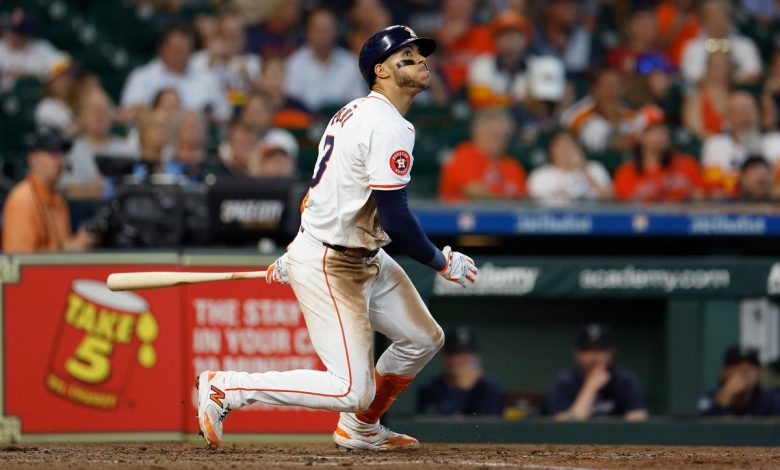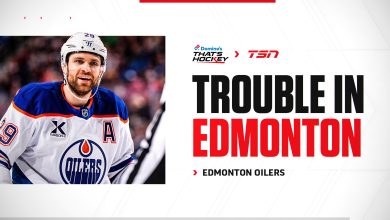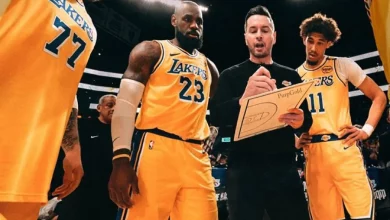Examining Jeremy Peña’s Fly Balls Quality of Contact Problem

As the Houston Astros continue their dominance in Major League Baseball (MLB), one of the players under significant scrutiny is Jeremy Peña. The young shortstop has been a key piece in the Astros’ success since he broke onto the scene in 2022, most notably taking home World Series MVP honors in his rookie season. However, as Peña’s second full season unfolds, one aspect of his game has raised questions: the quality of contact he makes on fly balls. While Peña is an elite defender and has the potential to be a strong offensive contributor, the issue with his fly ball contact could be limiting his offensive output and his ability to take his game to the next level.
In this analysis, we will explore the various aspects of Peña’s fly ball performance, dive into the specifics of quality of contact in relation to his fly ball metrics, and assess how his struggles might be addressed to improve his offensive consistency. Additionally, we’ll investigate the factors that could be contributing to Peña’s fly ball contact issues, including his swing mechanics, approach at the plate, and adjustments he may need to make going forward.
Peña’s Offensive Growth and Early Success
Jeremy Peña made an immediate impact when he was called up to the major leagues in 2022. Not only did he become a reliable defender at shortstop, but Peña’s bat showed promise as well. He slashed a respectable .253/.289/.426 in his rookie season, with 22 home runs and 63 RBIs. Peña’s ability to perform in high-leverage situations was even more impressive, including a remarkable postseason run that saw him take home the World Series MVP. Peña’s poise under pressure and his ability to contribute to the team’s offensive success were key elements of his rookie year.
In 2023, Peña continued to be a vital part of the Astros lineup, but his offensive numbers began to show some inconsistencies, particularly with fly balls. While Peña’s defensive prowess remained stellar, his ability to make solid contact on fly balls became a noticeable concern, especially when compared to his rookie season. A closer look at Peña’s fly ball quality of contact reveals potential mechanical flaws that are hindering his offensive performance.
The Concept of Quality of Contact
In order to understand the issue with Peña’s fly balls, it is crucial to first define the concept of quality of contact. In baseball, quality of contact refers to how well a player strikes the ball during an at-bat. Factors such as exit velocity, launch angle, and barrel percentage are key indicators of quality of contact. The barrel represents the sweet spot of the bat and results in the most optimal combination of exit velocity and launch angle. When a hitter connects with a ball in this area, it increases the chances of hitting the ball hard, making solid contact, and generating extra-base hits.
Fly balls, specifically, are defined as balls that are hit into the air with a launch angle greater than 10 degrees. Ideally, fly balls that are hit well should result in extra-base hits such as doubles, triples, or home runs, as opposed to routine fly outs. A hitter’s ability to maintain an efficient and consistent launch angle, combined with solid contact, is crucial for generating power and production in the form of extra-base hits or home runs.
Peña’s Fly Ball Contact: Metrics and Struggles
Looking deeper into Peña’s fly ball contact data, it’s clear that the young shortstop’s issues with quality of contact have affected his ability to drive the ball with authority. According to recent Statcast data, Peña’s average exit velocity on fly balls has been lower than league average. While his exit velocity on other types of contact (ground balls and line drives) is competitive, Peña has struggled to elevate the ball with sufficient velocity to consistently generate the types of extra-base hits that are typically expected from a hitter of his caliber.
In addition to the lower exit velocity, Peña’s launch angle has fluctuated, contributing to a lack of consistent quality on his fly balls. Ideally, Peña’s launch angle should fall in the range of 10-25 degrees to generate solid fly ball contact with power. However, Statcast has shown that Peña’s launch angle is often inconsistent, sometimes falling outside this optimal range, leading to weak fly outs or pop-ups rather than well-hit balls that clear the outfield fence.
Furthermore, Peña’s barrel percentage has been suboptimal, indicating that a significant portion of his fly balls are not being hit with the necessary power to drive the ball effectively. Barrel percentage measures the percentage of batted balls hit within the ideal launch angle and exit velocity range, and when this number is low, it means that the player is making contact but not with the necessary timing or precision to produce quality fly balls.
Potential Contributing Factors to Peña’s Fly Ball Struggles
Several factors could be contributing to Peña’s difficulties with fly ball quality of contact. Let’s explore some of the key issues that might be affecting Peña’s swing mechanics and decision-making at the plate.
1. Swing Mechanics and Adjustments
Peña’s swing mechanics, like many young players, could still be evolving as he works to refine his approach. When he came up to the big leagues in 2022, he displayed a solid, balanced swing, but as pitchers adjust to his tendencies, Peña may have found himself altering his mechanics in an attempt to adjust to different types of pitching. A swing that is inconsistent or out of sync with the ball can lead to weak fly balls, either due to poor timing, bat path inconsistencies, or failing to get the proper launch angle.
In particular, Peña’s swing mechanics might sometimes cause him to overswing or get out in front of pitches, resulting in weak contact or poorly hit fly balls. While his swing can generate power when timed correctly, his mechanics may leave him vulnerable to pitches up in the zone, leading to pop-ups or shallow fly balls rather than hard-hit drives.
2. Plate Discipline and Pitch Selection
Another important aspect of Peña’s struggles with fly ball quality of contact may lie in his plate discipline and pitch selection. Peña has shown signs of improving his ability to take pitches and work deep into counts, but there are times when he swings at pitches outside the strike zone or chases high fastballs. The pitches that Peña swings at tend to influence the quality of contact he makes, especially when it comes to fly balls.
Peña’s chase rate has been relatively high compared to league averages, and this tendency to expand the strike zone can result in weak contact or poor pitches to drive. If Peña continues to chase bad pitches, particularly high fastballs that lead to weak pop-ups, his fly ball contact will continue to suffer. Improving his pitch selection and focusing on swinging at pitches in his wheelhouse—pitches that he can drive with power—will be essential to improving his fly ball performance.
3. Adjusting to Pitchers and the League
As Peña faces more experienced pitchers over time, the league has adjusted to his strengths and weaknesses. The initial success that Peña experienced as a rookie could be partly attributed to pitchers not having a full scouting report on him. However, as more data becomes available, pitchers have started to exploit Peña’s weaknesses, especially his struggles with high fastballs and pitches on the edges of the zone.
As Peña continues to face the same pitchers year after year, he will need to adjust to their strategies and make changes to his swing and approach at the plate to maintain success. Adjusting his fly ball approach—by focusing on better timing, pitch selection, and swing mechanics—will be vital for Peña’s continued growth.
Potential Solutions and Adjustments for Peña
To improve his fly ball quality of contact, Peña will need to focus on several key adjustments.
1. Refining Swing Mechanics
Peña should work with the Astros’ coaching staff to further refine his swing mechanics, particularly his timing and approach to elevating the ball. Improving his ability to consistently get into proper launch angles and ensure solid contact will help him make better quality fly ball contact. In particular, making slight adjustments to his bat path or his approach to hitting higher pitches could reduce the number of weak fly balls and pop-ups.
2. Improving Plate Discipline
Improving plate discipline is another key area for Peña. By improving his ability to recognize pitches and lay off balls outside the zone, Peña can avoid swinging at pitches that are more likely to lead to weak fly balls or pop-ups. This could also help him work deeper counts and find better pitches to drive in favorable hitting situations.
3. Incorporating Video Analysis
Peña should also take advantage of the latest video analysis and data-driven tools to break down his swing and identify areas for improvement. By working with the Astros’ analytics staff, Peña can pinpoint the specific areas in his swing that may be causing weak fly ball contact and adjust accordingly.









